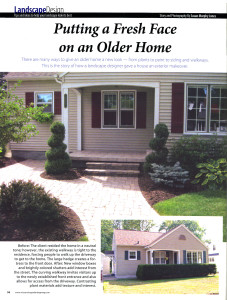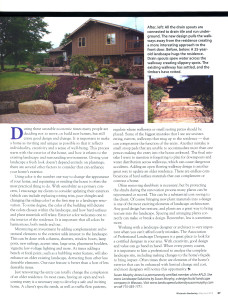Article originally published in Wisconsin Gardening Magazine May/June 2012 p. 56-57.
There are many ways to give an older home a new look – from plants to paint to siding and walkways. This is the story of how a landscape designer gave a house an exterior makeover.
Click on image to enlarge page.
During these unstable economic times many people are deciding not to move, or build new homes, but still crave good design and change. It is important to make a home as inviting and unique as possible so that it reflects individuality, creativity and a sense of well-being. This process starts with the exterior of the home, and how it relates to the existing landscape and surrounding environment. Giving your landscape a fresh look doesn’t depend entirely on plantings; there are several other factors to consider that can enhance your home’s exterior.
Using color is the number one way to change the appearance of your home, and repainting or residing the house is often the most practical thing to do. With sensibility as a primary concern, I encourage my clients to consider updating their exteriors (which can include replacing rotting trim, poor shingles and changing the siding color) as the first step to a landscape renovation. To some degree, the color of the building will dictate the colors chosen within the landscape, and how hard surfaces and plant materials will relate. Exterior color welcomes one to the interior of the residence. It is important that all colors be harmonious, both inside and out.
Minimizing an investment by adding completnentary architectural elements to the exterior adds interest to the landscape. This can be done with columns, shutters, window boxes, lamp posts, new railings, accent trim, large urns, placement boulders, vignette low voltage lighting and more. At times adding a bench or focal point, such as a bubbling water feature, will also enhance an older existing landscape, detracting from other less desirable elements. One nice feature is better than a host of less desirable items.
Just renovating the entry can totally change the complexion of an older residence. In most cases, having an open and welcoming entry is a necessary step to develop a safe and inviting home. A client’s specific needs, as well as traffic flow patterns, regulate where walkways or small resting patios should be placed. Some of the biggest mistakes that I see are uninteresting, narrow, walkways that snug up to the residence – that can compromise the function of the entry. Another mistake is small stoop pads that are unable to accommodate more than one person making the entry into the house awkward. The final mistake I want to mention is forgetting to plan for downspouts and water distribution across walkways, which can cause dangerous accidents. Adding an open flowing walkway design is another great way to update an older residence. There are endless combinations of hard surface materials that can complement or contrast a home.
Often removing shrubbery is necessary, but by protecting the shrubs during the renovation process many plants can be rejuvenated or moved. This can be a substantial cost saving to the client. Of course bringing new plant materials into a des ign is one of the most exciting elements of landscape architecture. Any good design has texture, and plants are a great way to bring texture into the landscape. Spacing and arranging plants correctly can make or break a design. Remember, less is sometimes more.
Working with a landscape designer or architect is very important when you can’t afford costly mistakes. The Association of Professional Landscape Designers is a great place to look for a certified designer in your area. With creativity, good design and value can go hand in hand. When every penny counts, it is important to hire a professional to analyze the complete landscape site, including making changes to the home’s facade to bring impact. Often times there are elements of the home’s exterior that can be enhanced with limited change and cost, and most designers will notice this opportunity.
Learn more about Wisconsin Gardening Magazine.

